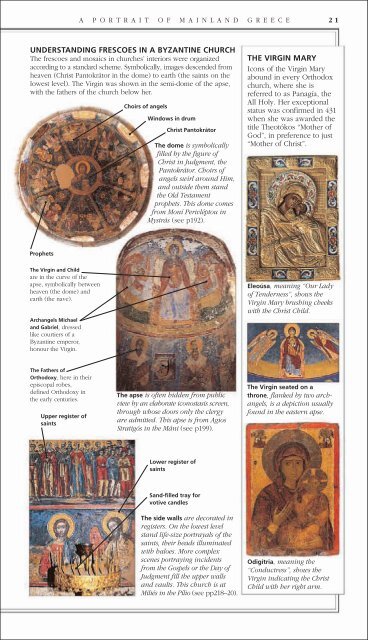You also want an ePaper? Increase the reach of your titles
YUMPU automatically turns print PDFs into web optimized ePapers that Google loves.
A PORTRAIT OF MAINLAND GREECE 21<br />
UNDERSTANDING FRESCOES IN A BYZANTINE CHURCH<br />
The frescoes and mosaics in churches’ interiors were organized<br />
according to a standard scheme. Symbolically, images descended from<br />
heaven (Christ Pantokrátor in the dome) to earth (the saints on the<br />
lowest level). The Virgin was shown in the semi-dome <strong>of</strong> the apse,<br />
with the fathers <strong>of</strong> the church below her.<br />
Prophets<br />
The Virgin and Child<br />
are in the curve <strong>of</strong> the<br />
apse, symbolically between<br />
heaven (the dome) and<br />
earth (the nave).<br />
Archangels Michael<br />
and Gabriel, dressed<br />
like courtiers <strong>of</strong> a<br />
Byzantine emperor,<br />
honour the Virgin.<br />
The Fathers <strong>of</strong><br />
Orthodoxy, here in their<br />
episcopal robes,<br />
defined Orthodoxy in<br />
the early centuries.<br />
Upper register <strong>of</strong><br />
saints<br />
Choirs <strong>of</strong> angels<br />
Windows in drum<br />
Christ Pantokrátor<br />
The dome is symbolically<br />
filled by the figure <strong>of</strong><br />
Christ in Judgment, the<br />
Pantokrátor. Choirs <strong>of</strong><br />
angels swirl around Him,<br />
and outside them stand<br />
the Old Testament<br />
prophets. This dome comes<br />
from Moní Perivléptou in<br />
Mystrás (see p192).<br />
The apse is <strong>of</strong>ten hidden from public<br />
view by an elaborate iconostasis screen,<br />
through whose doors only the clergy<br />
are admitted. This apse is from Agios<br />
Stratigós in the Máni (see p199).<br />
Lower register <strong>of</strong><br />
saints<br />
Sand-filled tray for<br />
votive candles<br />
The side walls are decorated in<br />
registers. On the lowest level<br />
stand life-size portrayals <strong>of</strong> the<br />
saints, their heads illuminated<br />
with haloes. More complex<br />
scenes portraying incidents<br />
from the Gospels or the Day <strong>of</strong><br />
Judgment fill the upper walls<br />
and vaults. This church is at<br />
Miliés in the Pílio (see pp218–20).<br />
THE VIRGIN MARY<br />
Icons <strong>of</strong> the Virgin Mary<br />
abound in every Orthodox<br />
church, where she is<br />
referred to as Panagía, the<br />
All Holy. Her exceptional<br />
status was confirmed in 431<br />
when she was awarded the<br />
title Theotókos “Mother <strong>of</strong><br />
God”, in preference to just<br />
“Mother <strong>of</strong> Christ”.<br />
Eleoúsa, meaning “Our Lady<br />
<strong>of</strong> Tenderness”, shows the<br />
Virgin Mary brushing cheeks<br />
with the Christ Child.<br />
The Virgin seated on a<br />
throne, flanked by two archangels,<br />
is a depiction usually<br />
found in the eastern apse.<br />
Odigítria, meaning the<br />
“Conductress”, shows the<br />
Virgin indicating the Christ<br />
Child with her right arm.


